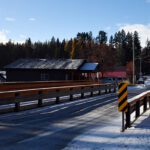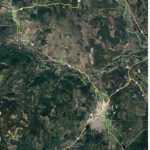Home »

Bighorn sheep don’t do social distancing
Op-Ed Commentary
This summer, a severe respiratory disease has shown up in British Columbia. Highly contagious, it moves quickly through a population with devastating effects, often lethal. Transmission is by sneezing, coughing and contaminated air-borne particles. Sound familiar?
No, it’s not COVID-19, though I certainly don’t mean to make light of our own pandemic in any way. This one involves wild sheep. Two bighorn lambs were recently identified as suffering from pneumonia caused by the bacteria Mycoplasma ovipneumoniae, commonly known as the more pronounceable Movi.
A CBC article relates how the two lambs near Penticton were observed to be suffering the classic symptoms of Movi: lethargy, dripping nose and diarrhea. They were put down and subsequent lab testing confirmed the Movi diagnosis.
The worst may be yet to come. Not unlike the novel coronavirus, Movi is wildly contagious among sheep with airborne transmission coming from nose-to-nose contact or sneezing. The pneumonia can spread rapidly through the entire herd. Though lambs suffer the greatest mortality rates, it affects all age classes in a bighorn herd. The most recent outbreak in British Columbia occurred near Clinton in 2013 with a loss of 80% of the herd.
 Bacteria-related die-offs have occurred in East Kootenay bighorn sheep, or kwiⱡqⱡi in Ktunaxa (pronounced roughly as KWITHK-thee), in the 1920s and 1960s. Another die-off in the 1980s implicated a variety-pack of pathogens including bacteria and lungworm.
Bacteria-related die-offs have occurred in East Kootenay bighorn sheep, or kwiⱡqⱡi in Ktunaxa (pronounced roughly as KWITHK-thee), in the 1920s and 1960s. Another die-off in the 1980s implicated a variety-pack of pathogens including bacteria and lungworm.
Movi does not necessarily act alone. Outbreaks are often associated with other bacterial strains and viruses, but Movi has been shown to be the bully in the group. Research shows it paralyses the cilia (or cellular “hairs”) in bighorn sheep lungs, leaving them unable to clear their lungs of mucus, dust or other pathogens.
The most frustrating part of Movi outbreaks in bighorn is that they are largely avoidable.
High school science taught us that it is based on asking questions, also called hypotheses, and testing those hypotheses in an attempt to refute them. As repeated tests fail to reject the hypothesis (that is, show that your idea was wrong) these become accepted as theories, or ideas with broad support. Scientific knowledge, however, must always be open to the possibility that evidence can show up to show your theory is wrong.
Thus, science has the habit of talking in probabilities instead of absolutes that many people find maddening. Think of reports on surveys and polls: “accurate within 3.2%, 19 times out of 20,” and so on.
The science on Movi in bighorn sheep, however, is about as clear as it gets. Infections in bighorn herds almost invariably come from contact between bighorn sheep and domestic sheep. Domestic goats and llamas have also been implicated, but domestic sheep are the big concern.

Movi is considered pervasive in domestic sheep flocks but, unlike their wild cousins, they are rarely affected by it. All animals, we humans included, have a highly diverse bacterial flora throughout our bodies, most of it benign if not beneficial. Movi is just part of domestic sheep. However, bighorns are highly susceptible to respiratory infections and Movi is almost always lethal to them.
Extensive research, much of it out of Washington State University in Pullman, has clearly demonstrated that a single nose-to-nose (or even within sneezing distance) contact between domestic and bighorn sheep can lead to infection. Being a highly social animal, the infected bighorn then returns to its herd and Movi bacteria quickly spreads.
Sheep just don’t do social distancing. Over the past 100 years, some 13 comingling experiments between wild and domestic sheep have all resulted in the death of wild sheep.
Hypothesis accepted, theory supported, the science is clear.
This is no reflection on the husbandry of domestic sheep. These are decidedly not dirty or diseased domestic sheep. The bacteria is pervasive and there is no known way to eliminate it from domestic sheep. It is simply a matter fact that where there’s domestic sheep, there’s Movi.
The answer is also clear. Domestic sheep should not be housed anywhere close to bighorn sheep range. In the East Kootenay, this includes much of the east side of the Kootenay and Columbia River: Radium Hot Springs / Stoddart Creek, east side of Columbia Lake, Bull River, Elko / Wigwam Flats and the Elk Valley above Sparwood. All areas with important bighorn winter range where opportunities are ripe for contact between bighorn and domestic sheep. One bighorn ram goes walkabout, comes across a domestic flock and the trouble starts.
 Unfortunately, excluding domestic sheep from private land is almost impossible.
Unfortunately, excluding domestic sheep from private land is almost impossible.
B.C.’s Farm Practices Protection Act, commonly called the Right to Farm Act, is a very powerful piece of legislation that guarantees opportunities to house livestock on private land. Previous attempts to exclude domestic sheep from wild sheep areas have failed in the face of the Right to Farm Act.
The BC Ministry of Forests, Lands, Natural Resource Operations and Rural Development leads a provincial BC Sheep Separation Program designed to work with private land owners and other stakeholders “to reduce the risk of disease transmission from domestic sheep and goats, to wild sheep” Single fencing is not enough; remember nose-to-nose contact or a good sneeze is enough to transmit the bacteria.
One option is a certification process similar to dolphin friendly tuna: Bighorn Friendly Lamb that ensures that lamb sold in stores, markets or served in restaurants is raised in a location that does not threaten wild sheep.
Beyond that, the province must recognize that some agricultural practices are simply not suitable in areas where wild sheep occur. This is a very small minority of private agricultural land in British Columbia. Failure to do so risks wild sheep that are highly valuable to British Columbians.

Wild sheep are one of the province’s highest economic generating wildlife species through hunting licenses, guiding and wildlife viewing. Intrinsic value is even higher: wild sheep are regarded by many people as an iconic species of the mountains. The Kootenays and B.C. would be greatly reduced without them.
We can’t legislate wild sheep to shelter-in-place, self-isolate and wear masks. We can, however, ensure that they are safely separated from domestic sheep, goats and llamas. We know how to avoid the vast majority of bacterial pneumonia die-offs in wild sheep. The province’s wildlife biologists understand what is at stake. We need the political will to make it happen.
Endnote: If you see wild sheep interacting with domestic sheep or goats, please immediately call the Report All Poachers and Polluters (RAPP) line at 1-877-952-7277.
Lead image: Bighorn Sheep at Radium Hot Springs. e-KNOW file photos








